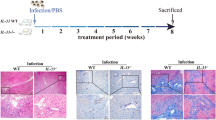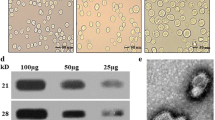Abstract
This study aims to gain a better insight into the transmission patterns and immunologic profile of Clonorchis sinensis infection and make a headway on the pathogenesis regarding cholangiocarcinoma and hepatic lesions. Experimental models orally infected by C . sinensis metacercariae were constructed in rats. Immunological assays were performed to measure serum level of IgA, IgE, IgG1, IgG2a, IFN-γ, and IL-4. Infection parameters were assessed by worm recovery rate, eggs per gram faece and worm size. Pathological sections with livers were managed with immunofluorescence, hematoxylin, eosin, and Masson's trichrome staining to evaluate the hepatic pathological changes. Interestingly, rats infected with only one C . sinensis metacercariae even gained a high worm recovery rate of 83.3% compared with rats infected with more metacercariae. Serological changes according to different infection doses indicated that immune response presented a tendency to Th2 type by expressing transient high level of IgG1, IL-4, and IgE. Hepatic tissues appeared inflammatory and fibrotic, revealed by different stainings. Intrahepatic bile ducts displayed cholangiectasis and proliferation with excreted/secreted antigen histologically located. C . sinensis, as a fish-borne zoonosis, presented novel transmission patterns which explained high infection rate in endemic areas; infection rate of C . sinensis was frequency-dependent and dose-related. Humoral immunity played a prevalent role in resisting to C . sinensis based on the rat models. C . sinensis infection played an undoubted role in biliary and hepatic diseases.





Similar content being viewed by others
References
Choi D, Hong ST (2007) Imaging diagnosis of clonorchiasis. Korean J Parasitol 45(2):77–85
Choi YK, Yoon BI, Won YS, Lee CH, Hyun BH, Kim HC, Oh GT, Kim DY (2003) Cytokine responses in mice infected with Clonorchis sinensis. Parasitol Res 91(2):87–93
Choi BI, Han JK, Hong ST, Lee KH (2004) Clonorchiasis and cholangiocarcinoma: etiologic relationship and imaging diagnosis. Clin Microbiol Rev 17(3):540–552
Chuang SC, Vecchia CL, Boffetta P (2008) Liver cancer: descriptive epidemiology and risk factors other than HBV and HCV infection. Cancer Lett (in press)
Fang YY, Pan B, Shi XC, Chen ZZ, Lin RX, He Q et al (2000) Comparative analysis of two surveys of distribution of human parasites in Guangdong province. Strait J Prevent Med 6:32–33 (in Chinese)
Finkelman FD, Pearce EJ, Urban JF Jr, Sher A (1991) Regulation and biological function of helminth-induced cytokine responses. Immunol Today 12:62–66
Hou PC (1955) The pathology of Clonorchis sinensis infestation of the liver. J Pathol Bacteriol 70(1):53–64
Hu FY, Hu XC, Ma CL, Xu J, Yu XB (2009) Excretory/secretory antigens from Clonorchis sinensis induces hepatic fibrosis in rats. Nan Fang Yi Ke Da Xue Xue Bao 29:393–396 (in Chinese)
Liang C, Hu XC, Lv ZY, Wu ZD, Yu XB (2009) Maintain of life cycle of Clonorchis Sinensis indoors. Zhong Guo Ji Sheng Chong Xue Yu Ji Sheng Chong Bing Za Zhi 27:148–150 (in Chinese)
Lin AC, Chapman SW, Turner HR, Wofford JD (1987) Clonorchiasis: an update. South Med J 80(7):919–922
Luigi A, Giuseppe P, Andrea P (2009) Hepatic stellate cell: a star cell in the liver. Int J Biochem Cell Biol 41(8–9):1639–1642
Lun ZR, Gasser RB, Lai DH, Li AX, Zhu XQ, Yu XX, Fang YY (2005) Clonorchiasis: a key foodborne zoonosis in China. Lancet Infect Dis 5(1):31–41
Pan B, Fang YY, Yang WS (2000) Current situation and control strategy of parasitic diseases in Guangdong province. Ann Bull Soc Parasitol Guangdong 22:85–89 (in Chinese)
Park DH, Son HY (2008) Images in clinical medicine. Clonorchis sinensis. N Engl J Med 358(16):e18
Pearce EJ, Reiner SL (1995) Induction of Th2 responses in infectious disease. Curr Opin Immunol 7(4):497–504
Quan FS, Matsumoto T, Shin YO, Min YK, Yang HM, Lee JB (2004) Relationships between IgG, IgM, IgE and resistance to reinfection during the early phase of infection with Clonorchis sinensis in rats. Immunol Invest 33(1):51–60
Rim HJ (2005) Clonorchiasis: an update. J Helminthol 79(3):269–281
Shin HR, Lee CU, Park HJ, Seol SY, Chung JM, Choi HC, Ahn YO, Shigemastu T (1996) Hepatitis B and C virus, Clonorchis sinensis for the risk of liver cancer: a case-control study in Pusan, Korea. Int J Epidemiol 25(5):933–940
Sohn WM, Zhang H, Choi MH, Hong ST (2006) Susceptibility of experimental animals to reinfection with Clonorchis sinensis. Korean J Parasitol 44(2):163–166
Waldvogel AS, Lepage MF, Zakher A, Reichel MP, Eicher R, Heussler VT (2004) Expression of interleukin 4, interleukin 4 splice variants and interferon gamma mRNA in calves experimental infected with Fasciola hepatica. Vet Immunol Immunopathol 97(1–2):53–63
Watanapa P, Watanapa WB (2002) Liver fluke—associated cholangiocarcinoma. Br J Surg 89(8):962–970
Yang LC, Huang BY, Xue GF, Li XL, Mo DL (2004) Relationship between infection of Clonorchis sinensis and hepatobiliary and pancreatic diseases. Chin J Hepatobiliary Surg 10:165–166 (in Chinese)
Zhang HM, Chung BS, Li SY, Choi MH, Hong ST (2008) Factors in the resistance of rats to re-infection and super-infection by Clonorchis sinensis. Parasitol Res 102:1111–1117
Zheng NC, Jin X, Wu ZD, Chen JZ, Hu XC, Song LX, Yang G, Ji CN, Chen SY, Gu SH, Ying K, Yu XB (2005) Clonorchis sinensis: molecular cloning and functional expression of novel cytosolic malate dehydrogenase. Exp Parasitol 109(4):220–227
Zhou Z, Xia H, Hu X, Huang Y, Li Y, Li L, Ma CL, Chen XX, Hu FY, Xu J, Wu ZD, Yu XB (2008) Oral administration of a Bacillus subtilis spore-based vaccine expressing Clonorchis sinensis tegumental protein 22.3 kDa confers protection against Clonorchis sinensis. Vaccine 26(15):1817–1825
Acknowledgment
This work was supported by the National Natural Science Foundation grant funded by National Natural Science Foundation of China (no.30671831) and the National High Technology Research and Development Program of China (973 program; no.2010CB530000). We would like to thank Doctor Yili Huang at Pathology Department in Cancer Center of Sun Yat-sen University for the pathological work in this article.
Author information
Authors and Affiliations
Corresponding author
Rights and permissions
About this article
Cite this article
Wang, X., Liang, C., Chen, W. et al. Experimental model in rats for study on transmission dynamics and evaluation of Clonorchis sinensis infection immunologically, morphologically, and pathologically. Parasitol Res 106, 15–21 (2009). https://doi.org/10.1007/s00436-009-1622-7
Received:
Accepted:
Published:
Issue Date:
DOI: https://doi.org/10.1007/s00436-009-1622-7




